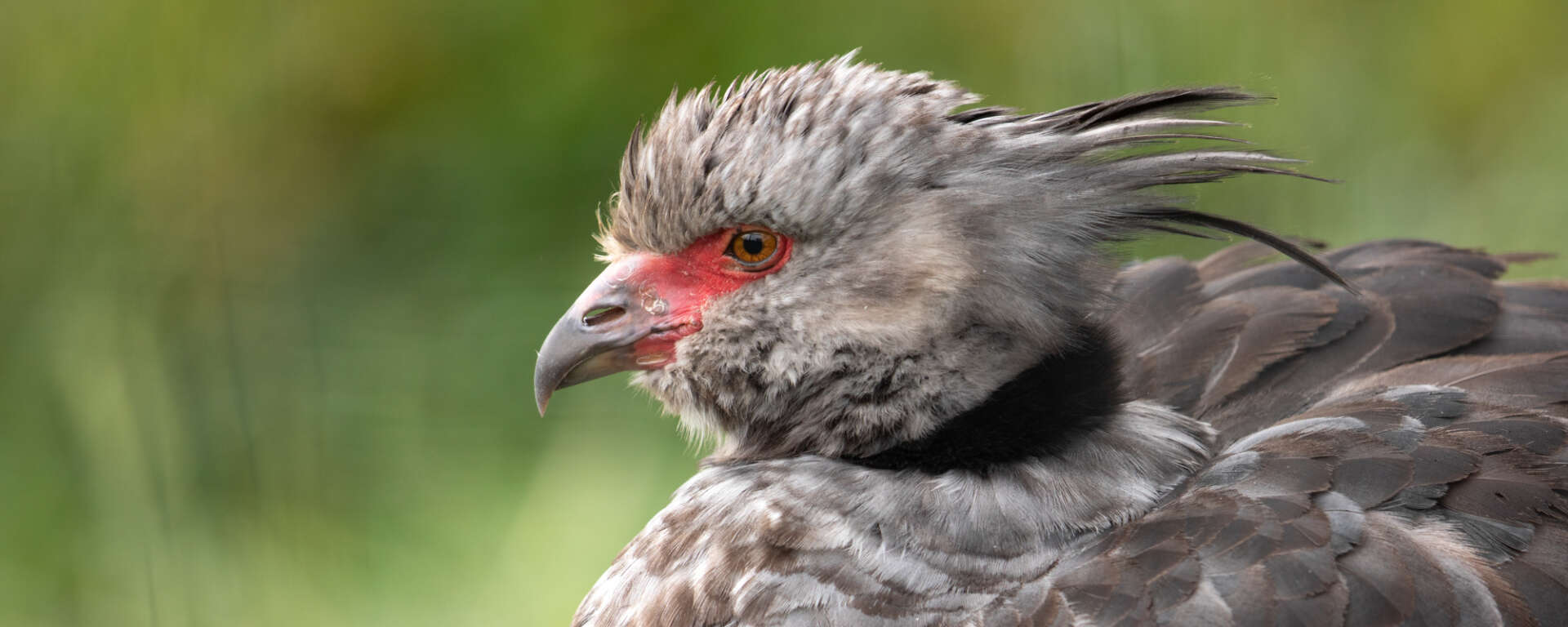Description
The Crested Screamer, also known as the Southern Screamer, has reddish skin around the eyes. Most of the body feathers are a mottled grey-black; the head is small compared to the body, as is the short hooked bill. A band of dark feathers with a thin white collar above it circles the throat. There is a crest of feathers on the back of the head. No feathers are found on the thick legs. Screamers have long toes, hollow bones even in their toes and lots of air sacs in their body and skin; these are adaptations to their semi-aquatic lifestyle.
Classification
- Class
- Aves
- Order
- Anseriformes
- Family
- Anhimidae
- Genus
- Chauna
- Species
- C. torquata
- Conservation Status
- Least Concern
Key Facts
- Body Length
- 81-95 cm (32-37 in)
- Weight
- 3-5 kg (6.6-11.0 pounds)
- Wingspan
- 170 cm (67 in)
Social Life
Screamers are gregarious birds. They live in large flocks until the mating season when the screamers pair off. Screamers prefer to feed on the ground, even though they are strong swimmers and fliers. Screamers have spurs (sharp claws) at the bend of their wings, used to defend against predators. Unmated males also use the spurs when fighting with other males for dominance or females.
Habitat and Range
Native to South America, it is found in wetlands and grasslands of southern Peru, Northern Bolivia and parts of Brazil and Argentina.
Diet
Screamers eat seeds, grasses, plant stems, leaves and very occasionally small animals.
Lifespan
About 15 years
Predators
The main threat to Screamers is habitat loss. They are seldom caught and eaten by humans as the flesh is filled with air sacs, making it is spongy and unpalatable. However, chicks are often taken to raise with domestic fowl such as chickens and ducks, since the Screamers make great guard birds.
Reproduction
Screamers mate for life and are monogamous. Both parents build the five foot high platform nest from sticks, leaves and aquatic plants, usually near water and preferably inaccessible. After the female lays two to seven white eggs, they both brood the eggs. Chicks hatch after 43 to 46 days and leave the nest immediately. Parents continue to care for the chicks for eight to fourteen weeks.
- Information
-
Description
The Crested Screamer, also known as the Southern Screamer, has reddish skin around the eyes. Most of the body feathers are a mottled grey-black; the head is small compared to the body, as is the short hooked bill. A band of dark feathers with a thin white collar above it circles the throat. There is a crest of feathers on the back of the head. No feathers are found on the thick legs. Screamers have long toes, hollow bones even in their toes and lots of air sacs in their body and skin; these are adaptations to their semi-aquatic lifestyle.
Classification
- Class
- Aves
- Order
- Anseriformes
- Family
- Anhimidae
- Genus
- Chauna
- Species
- C. torquata
- Conservation Status
- Least Concern
Key Facts
- Body Length
- 81-95 cm (32-37 in)
- Weight
- 3-5 kg (6.6-11.0 pounds)
- Wingspan
- 170 cm (67 in)
- Lifestyle
Social Life
Screamers are gregarious birds. They live in large flocks until the mating season when the screamers pair off. Screamers prefer to feed on the ground, even though they are strong swimmers and fliers. Screamers have spurs (sharp claws) at the bend of their wings, used to defend against predators. Unmated males also use the spurs when fighting with other males for dominance or females.Habitat and Range
Native to South America, it is found in wetlands and grasslands of southern Peru, Northern Bolivia and parts of Brazil and Argentina.Diet
Screamers eat seeds, grasses, plant stems, leaves and very occasionally small animals.
Lifespan
About 15 years
Predators
The main threat to Screamers is habitat loss. They are seldom caught and eaten by humans as the flesh is filled with air sacs, making it is spongy and unpalatable. However, chicks are often taken to raise with domestic fowl such as chickens and ducks, since the Screamers make great guard birds.Reproduction
Screamers mate for life and are monogamous. Both parents build the five foot high platform nest from sticks, leaves and aquatic plants, usually near water and preferably inaccessible. After the female lays two to seven white eggs, they both brood the eggs. Chicks hatch after 43 to 46 days and leave the nest immediately. Parents continue to care for the chicks for eight to fourteen weeks.

